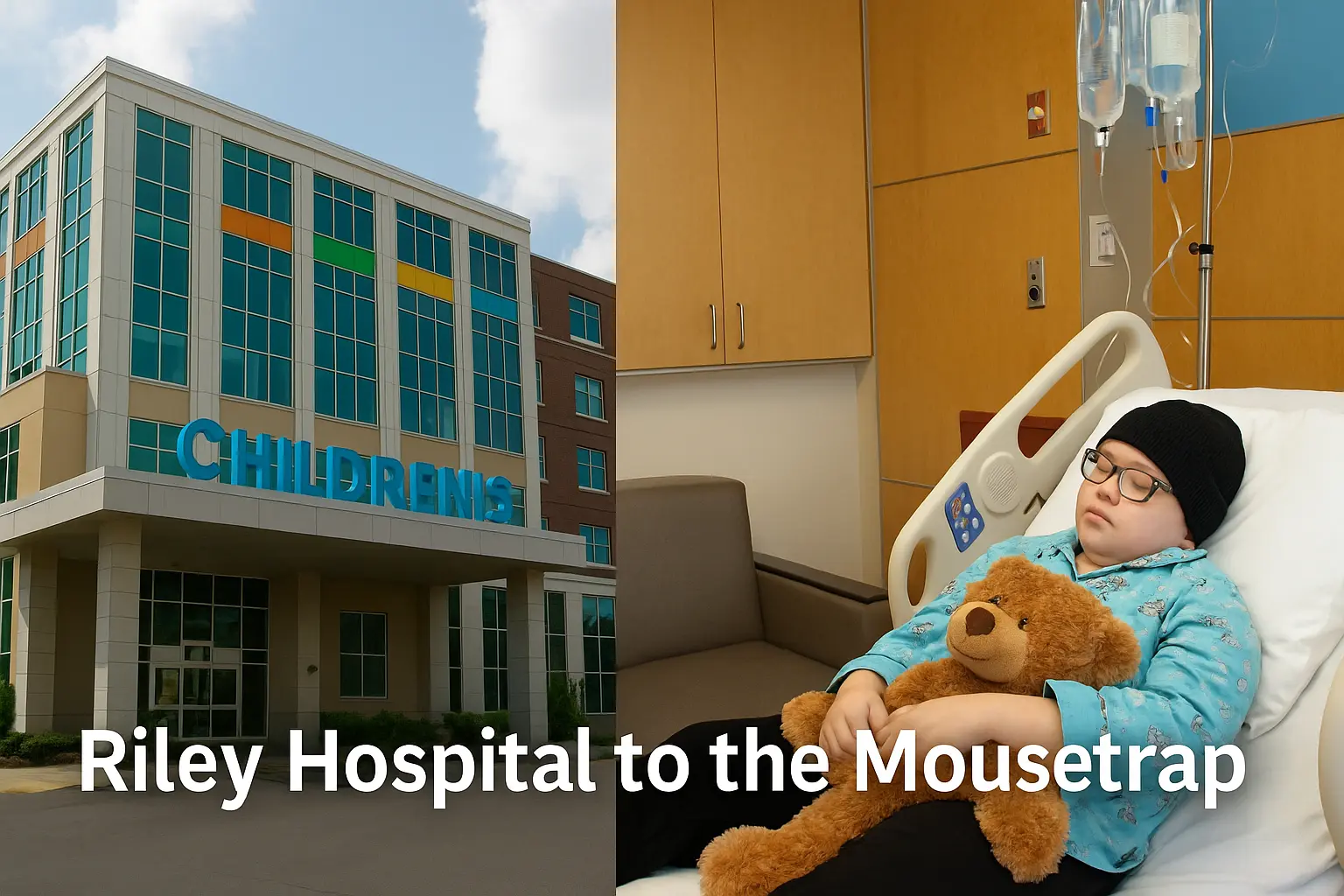At first glance, the phrase riley hospital to the mousetrap sounds unusual, even contradictory: one stands for healing and the other for mystery. Yet when you look closer, it reflects a deeper reality about community life. Hospitals and local venues, including those known as The Mousetrap, often become partners in events that raise funds, awareness, and morale for children’s health care. In that sense, riley hospital to the mousetrap captures the journey from treatment rooms to theatre seats, from medical precision to creative expression. It shows how every corner of a city can participate in the healing process.
The connection is not merely symbolic. Across Indiana, for example, local bars, theatres, and performance spaces have hosted charity nights that benefit children’s hospitals. When communities organize these gatherings, they create spaces where laughter, music, and mystery coexist with purpose. That simple act of bringing people together transforms the phrase riley hospital to the mousetrap from a random pairing into a meaningful story about hope and collective action.
Understanding Riley Hospital and its community impact
Riley Hospital for Children has long stood as a cornerstone of pediatric care. It offers specialized services, cutting-edge research, and family-centered programs that reach far beyond its walls. For thousands of families, it represents more than a hospital—it’s a lifeline. The staff’s commitment to compassion and innovation defines what modern health care should look like: equal parts science and humanity.
Yet Riley’s influence doesn’t end with medicine. Its foundation works tirelessly to connect with local organizations, businesses, and arts venues. Every year, partnerships and charity events help fund research programs, provide family housing, and support services that ease the burden of treatment. The movement from riley hospital to the mousetrap represents those outreach efforts: the path that takes care from the hospital to the heart of the city, where the arts and community spirit amplify its message.
The legacy of The Mousetrap — more than just a name
When people hear “The Mousetrap,” their minds usually jump to Agatha Christie’s legendary play. The production has been running for decades, setting records as the longest continuous performance in theatre history. It’s a story of suspense, wit, and human psychology—qualities that mirror the tension and resilience often found in hospital life. In many ways, the mystery of The Mousetrap reflects the uncertainty patients and families face while awaiting diagnoses and treatment outcomes.
But “The Mousetrap” is also the name of real places: local bars, music lounges, and theatre spaces that bring people together. In Indianapolis, The Mousetrap is a community venue known for live music and events that sometimes double as fundraisers for local causes. It’s not hard to imagine a night when a band dedicates its performance to the children of Riley Hospital, turning entertainment into empathy. So when people talk about riley hospital to the mousetrap, they are often pointing to that transformation—a moment when ordinary leisure becomes a force for healing.
How local venues support hospitals through creativity
The distance from riley hospital to the mousetrap is not measured in miles but in intention. Local venues have long served as gathering points where generosity thrives. When a place like The Mousetrap hosts a benefit event, the impact can ripple far beyond one evening. Ticket proceeds help fund patient care, community members learn about pediatric programs, and families gain comfort knowing others care.
These events can take many forms. Some are concerts featuring local bands, others are trivia nights themed around mystery and theatre, echoing the suspenseful atmosphere of Agatha Christie’s play. Each occasion turns fun into purpose. The people who attend may come for the music, but they leave with a deeper connection to the hospital’s mission. That’s the true essence of riley hospital to the mousetrap—an ongoing conversation between healing spaces and creative stages.
The emotional power of storytelling and performance
There’s a reason why hospitals often invite musicians, artists, and actors to engage with patients: stories and performances heal in ways that medicine alone cannot. A melody can ease anxiety, a dramatic scene can inspire laughter, and a familiar story can remind children that challenges can be overcome. These experiences turn sterile environments into spaces of imagination and comfort.
Likewise, when community members gather at a venue like The Mousetrap, they engage in collective storytelling. Every ticket, every cheer, every moment of shared enjoyment becomes part of a larger narrative about resilience and compassion. The connection from riley hospital to the mousetrap represents how those narratives loop back, with funds and morale returning to support young patients and their families.
Why community partnerships matter more than ever
Health care can’t thrive in isolation. It depends on networks of support—donors, volunteers, artists, teachers, and business owners—all working toward a shared goal. By forming creative partnerships, hospitals stay connected to the humanity of their mission. When people gather at a show or community night and realize that their fun contributes to healing, the effect is profound.
In practical terms, community events also raise awareness. They remind citizens that children’s hospitals rely on continued support for research, facilities, and family services. Each time someone mentions riley hospital to the mousetrap, they reinforce this idea: that small acts of creativity, when multiplied, can sustain major institutions of care.
Organizing a benefit event: turning an idea into action
Anyone can help bridge the gap between riley hospital to the mousetrap. Planning a benefit event doesn’t require professional experience—just motivation and coordination. A good starting point is identifying a venue willing to host. Once the space is secured, organizers can set up themes that resonate: a mystery-themed dinner, a live band night, or an art show featuring local talent.
Promotion is key. Using social media, local news outlets, and community bulletin boards can attract diverse crowds. Transparency about how proceeds are used builds trust. Partnering with hospital representatives ensures that the funds reach the right programs and that participants understand the impact of their contributions. The goal isn’t only to raise money but also to strengthen relationships among those who care.
Beyond money: the cultural link between care and creativity
Not every connection from riley hospital to the mousetrap has to involve fundraising. Sometimes it’s simply about visibility and cultural exchange. When hospitals showcase children’s artwork at local galleries or when musicians perform for patients, both sides gain perspective. Creativity fosters empathy; it allows people to understand complex emotions through shared expression.
This kind of collaboration benefits everyone involved. Artists find deeper purpose in their work, communities feel united, and hospitals gain advocates who carry their stories outward. Over time, these collaborations create a tradition—a cycle of giving and receiving that reflects the best of human nature.
The symbolic meaning of riley hospital to the mousetrap
Symbolically, riley hospital to the mousetrap represents the balance between vulnerability and strength. A hospital embodies compassion in the face of pain; a theatre or performance hall symbolizes expression and release. Together, they illustrate how humans navigate difficulty through connection and creativity.
In children’s health care especially, this symbolism matters. Young patients often respond better to environments filled with music, play, and imagination. When the broader community mirrors that support—through theatre nights, concerts, or local events—it creates a continuous circle of healing. Every note played and every ticket sold echoes back to the hospital halls where hope is needed most.
The future of community-based hospital support
Looking ahead, partnerships like riley hospital to the mousetrap will only grow in importance. As hospitals adapt to new challenges and funding models, grassroots involvement becomes essential. Digital promotion, live-streamed events, and hybrid fundraisers expand the reach of local efforts. A concert held at a small venue can now be broadcast online, drawing in supporters from across the country.
The next generation of organizers is already blending creativity with cause. They understand that giving doesn’t always mean writing a check; it can mean attending a show, volunteering time, or spreading awareness. That modern approach keeps both the arts and healthcare systems vibrant and interconnected.
A human story of connection
When people describe riley hospital to the mousetrap, they might not realize how much meaning those words carry. Behind them lie countless stories—of children regaining strength, of musicians playing for a cause, of strangers united by empathy. It’s proof that the best parts of a city are not its buildings but its bonds.
Every community needs those bridges between care and culture. Whether through theatre, music, or storytelling, the journey from hospital to stage remains one of humanity’s most powerful routes toward understanding and hope.
Conclusion
The phrase riley hospital to the mousetrap serves as a reminder that healing is not confined to hospitals alone. It extends into neighborhoods, venues, and hearts willing to help. The arts amplify that healing by transforming compassion into action and creativity into contribution. When communities recognize their shared role in supporting children’s health, they create an unbroken link between care and celebration. And in that unity, both medicine and art find their highest purpose.
FAQs
What does the phrase “riley hospital to the mousetrap” represent?
It refers to the symbolic and practical connections between a children’s hospital and community venues or performances that support its mission.
Is there a real partnership between Riley Hospital and The Mousetrap?
Several community events and benefit nights have been organized in local venues known as The Mousetrap to raise funds or awareness for children’s health programs.
Why is community involvement important for hospitals?
Because it builds trust, spreads awareness, and turns public participation into tangible support for patient care and family services.
How can small venues contribute to children’s health care?
By hosting benefit concerts, charity nights, or themed events that donate proceeds to hospitals or related foundations.
What’s the lasting message of riley hospital to the mousetrap?
That healing and creativity are deeply intertwined, and when communities come together, even a night of music or theatre can make a lasting difference.


